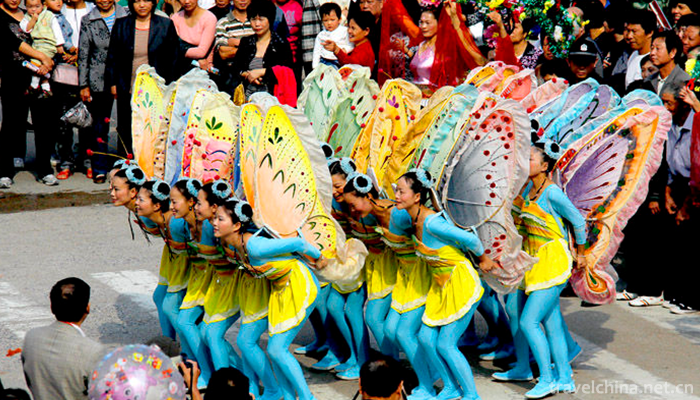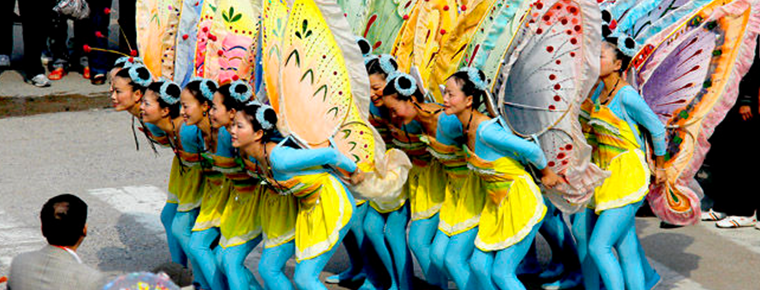Eighteen Butterflies
Eighteen Butterflies
Eighteen butterflies is a local traditional dance form popular in the central part of Zhejiang Province (mainly in the area of Jinhua Yongkang). Twenty young women play the whole set of eighteen butterflies. Two are decorated with flower gods and eighteen are decorated with butterflies.
On June 7, 2008, the "Eighteen Butterflies" declared by Yongkang City, Zhejiang Province, were listed in the second batch of national intangible cultural heritage lists with the approval of the State Council. Heritage serial number: 644 III-47.
historical significance
Yongkang City is located in Jinhua City, central Zhejiang Province. There are Fangyan Mountains in Yongkang City. It is the place where the famous folk custom "Fangyan Temple Fair" takes place and takes place. Fangyan Temple Fair originated from the local people's folk belief in Hu Ze. Hu Ze (963-1039), a famous Minister of the Northern Song Dynasty, was born in Yongkang. He was a scholar in 1989 (Duanggong two years). Then he arrested three dynasties (Taizong, Zhenzong and Renzong). At the age of 71, he served as a military minister. According to the Yongkang County Chronicle, it is recorded that "Wu body and Ding Qian without Qu are tasted, people cherish their virtues, household statues are worshipped, in Fangyan, the grant is called the Heling Temple." Afterwards, Hu Ze was worshipped as a God by the people and called "Hu Gong Dadi". Every year from August 13 (Hu Ze's birthday) to Chongyang Festival, Fangyan holds a grand temple fair. Villagers from all over Yongkang organize folk performing teams such as "Luohan Team" and "Mussel Shell Dance", and the rock above worships "Hu Gong". In the autumn of 1946, Wang Chunshan, a villager in Gaozhen, 7 miles east of Yongkang City, and others, inspired by the "mussel shell dance", produced "butterfly" props, arranged dance formations, and participated in Fangyan Temple Fair. Thus, a beautiful and unique "Eighteen Butterflies" was born, which transformed from "mussel shell dance" into "big fly" and "small fly" with similar themes and movements.
artistic characteristics
Basic movements
The basic movements of the butterfly dance are only "big fly" and "small fly". Their common characteristics are: the swing of the hand and the footsteps are closely coordinated; the flying action is the sway of the strong beat forward; the center of gravity of the action is below. The actors put their hands on their backs and swing their arms back and forth, driving the wire ring that connects the wings in the middle of their arms to flap their wings, and taking the "twist step" of their feet, the body twists naturally with the pace. The basic characteristics are "slow but not heavy". That is, the whole movement is slow, gentle, slow and fast, the body sinks and floats down, can fly up, there is a pause without any trace. "Xiaofei" movement is swinging fast frequency, small amplitude, step by step, sometimes left, right waist flying. The basic features are "light but not floating", that is, brisk dance steps, flexible shoulder joints, air-stable body end; neither lose the sense of flight nor lose the sense of rhythm. Flower god's basic action is to take the "round field step" with his feet and throw the ribbon outward alternately with his hands.
artistic characteristics
"Eighteen Butterflies" is famous for its "three sexes":
Art, through clothing, props, music and dance, as well as the beautiful body of a beautiful girl, contains elegant, beautiful charm. Stretching elegant dancing posture and melodious music are representative programs with typical characteristics of traditional folk dances of women in the south of the Yangtze River.
Entertainment, adapted to the performance of temple fairs entertainment activities, it can be performed on the stage, square, scenic spot, even in the streets and lanes, once performed, it will attract nearby villagers or tourists to watch;
Participation, because the action is not difficult, and the image is vivid and beautiful, so Yongkang local countryside and even nearby counties and cities, as long as interested can organize performances, villagers are enthusiastic, competing to participate.
"Eighteen Butterflies" implies the harmony between man and man, man and nature, eulogizes the truth, goodness and beauty, better reflects the beautiful beauty of Jiangnan culture, widely welcomed by the masses.
Current situation of inheritance
Folk stage "Eighteen Butterflies" was processed and sorted out by Lv Yinchan and Hu Chunmei. In the spring of 1957, it participated in Zhejiang folk music and dance performance and won the first prize.
In 1959, he won the performance prize in the provincial music and dance concert, and participated in the May 1st masquerade parade.
In the spring of 1978, Lv Zhiqiang, Wang Jinxuan and Hu Chunmei changed their names to "Colorful Butterflies Inviting Spring" by composing lyrics by Mugo and Baifan again, and they participated in the Jinhua regional performance and won the performance award.
In October 1984, he participated in the performance and parade of "Sino-Japanese Youth Festival" in Hangzhou, recorded and broadcast by central and provincial radio stations, and recorded and filed by provincial cultural department.
In 1987, after Dai Xianjue's arrangement, he was selected into "Zhejiang Volume of Folk Dance Integration";
In 1987, he won the first prize for performance in Zhejiang folk music and dance concert.
In 1992, he won the Best Performance Award, the Best Organization Award and the Best Director Award at the Second International Friendly City Art Festival.
In 1992, Zhejiang Province went to Shenyang and Tianjin to participate in the International Yangko Festival. In the same year, Zhejiang Province won all six prizes in the national folk art contest in the National Excellent Folk Dance Competition.
In 1993, he was awarded the second Silver Award of the "Stars Award" of the Ministry of Culture and the Zhejiang Spiritual Civilization Works Award. Following that, the National Square Folk Culture and Art Festival held in Quanzhou, Shanghai and other cities has won many awards.
In June 1997, he flew to France on behalf of China to attend five folk art festivals, such as the 25th Sant State Folk Art Festival, which caused a sensation and won glory for the country, and was commended by Zhejiang Provincial Culture Department.
"Eighteen Butterflies" is prevalent because of its dependence on the activities of entertaining gods at Fangyan Temple Fair. With the progress of the times, the concept of folk beliefs of "Hu Gong-bao" has gradually faded, and the number of people participating in the performance has become fewer and fewer. Moreover, its props production is more difficult, the color painting process is more complex and difficult to preserve, and today's production technology is on the verge of loss.


-
1.Shanghai Science and Technology Museum
Shanghai Science and Technology Museum is a comprehensive natural science and technology museum with Chinese characteristics, times characteristics and Shanghai characteristics
Time 2018-12-05 -
2.Qiangcheng Tourist Area Beichuan
Mianyang Beichuan Qiang Town Tourist Area is located in Beichuan Qiang Autonomous County, northwest of Sichuan Basin. It consists of Beichuan Earthquake Relics Area, Beichuan New County Town
Time 2018-12-12 -
3.Yeliguan Scenic Area
Yeliguan Scenic Area is located in Lintan County, with Yeliguan of Lintan County as the center. It is divided into four scenic areas: Lianhuashan, Xixia, Dongxia and Yehai Lake.
Time 2018-12-26 -
4.Nanhai Chan Temple
Nanhai Chan Temple, a national AAAA scenic spot, is located in the southeast corner of Runan County, Zhumadian City, Henan Province, China
Time 2019-02-07 -
5.Sun Tzu Cultural Park
Sun Tzu Cultural Park is located in the East New Area of Guangrao County. It has been listed in the "four batches" key dispatching and promotion projects of the Yellow River Delta High Effic
Time 2019-02-13 -
6.Manufacturing Techniques of Spotted Copper
The bronze production technology, the traditional handicraft of Qujing City, Yunnan Province, is one of the national intangible cultural heritage.
Time 2019-04-03 -
7.Wind and Fire Meteor
Fenghuo Meteor is a traditional folk performing art which combines acrobatics and martial arts. It is one of the first intangible cultural heritages in Shanxi Province.
Time 2019-04-29 -
8.Copying and Reproducing Skills of Ancient Calligraphy and Painting
Ancient painting and calligraphy copying technology, the traditional copying technology of Beijing Palace Museum, one of the national intangible cultural heritage.
Time 2019-05-01 -
9.Jingdong drum
Jingdong Drum is a traditional rap art originating in Sanhe, Xianghe, Pinggu and Baodi of Hebei Province. The main instruments, in addition to the singer's left hand with copper plate,
Time 2019-05-07 -
10.Legend of Wang Zhaojun
Wang Zhaojun's legend is one of the local folklores in Xingshan County, Hubei Province. Wang Zhaojun, one of the four beautiful women in ancient China, is the embodiment of beauty, the messenger of pe
Time 2019-06-26 -
11.The Custom of Collecting Ginseng in Changbai Mountain
The custom of collecting ginseng in Changbai Mountain has a long history. As early as the middle of the 3rd century, ginseng has been excavated. In order to survive and find, excavate and preserve gin
Time 2019-07-25 -
12.Jiang Weicheng
Jiangweicheng site is a representative and important site in the upper reaches of Minjiang River. It is located in the mountain behind the Weishi school in Weizhou Town, Wenchuan County.
Time 2020-11-06